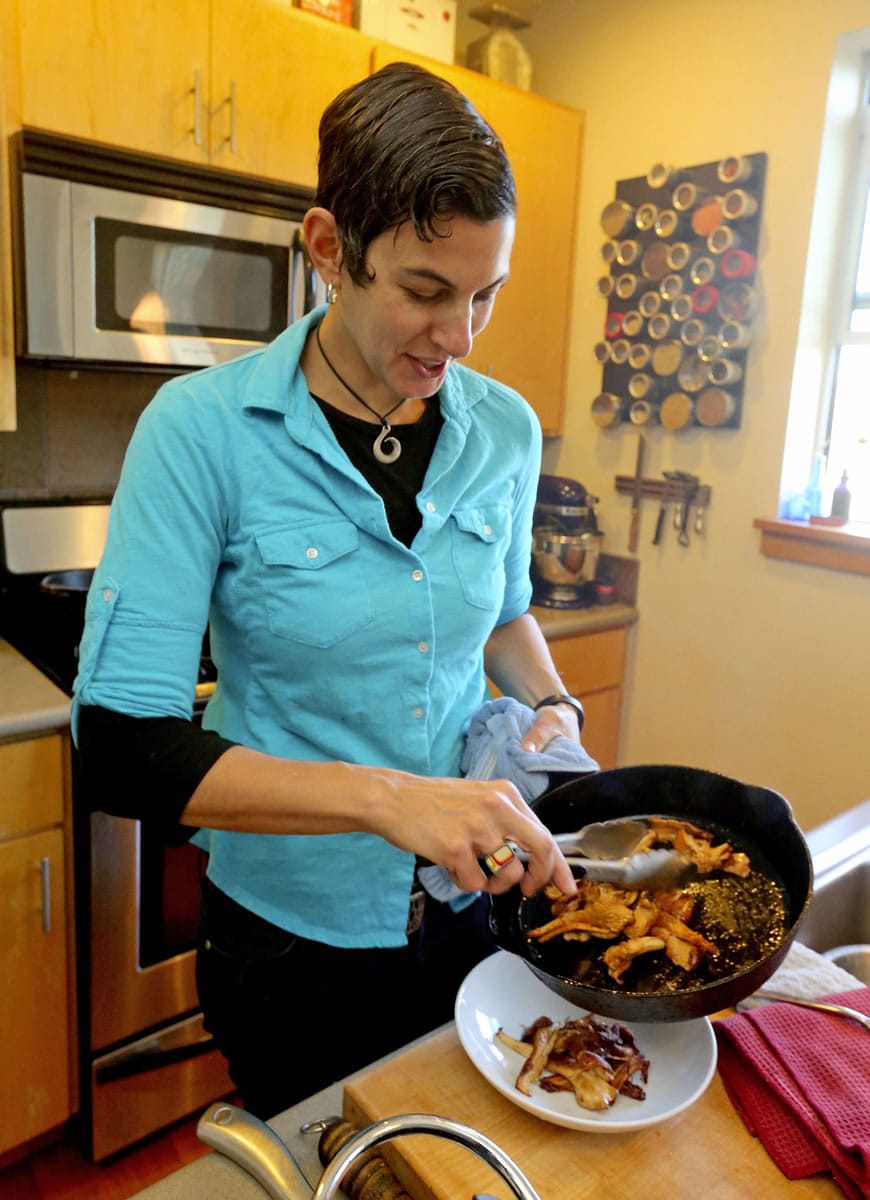The simple button mushroom isn’t alone anymore in the grocery store.
Well-stocked markets are offering chanterelles, shiitakes, porcinis, even vibrant red lobster mushrooms or pricey perfumed matsutakes.
The mushrooming supply is a potential bonanza for home cooks. But, as personal chef and cooking instructor Becky Selengut found in her Seattle cooking classes, it’s also confounding.
“People were saying they were intimidated by the supermarkets now having eight, nine, 10 different kinds of mushrooms” when they had only cooked with one, she said. Her answer: A new book, “Shroom: Mind-bendingly Good Recipes for Cultivated and Wild Mushrooms” (Andrews McMeel, $35). It’s an introduction, in her accomplished and witty way, to 15 reasonably common mushroom varieties, with advice on how to select and cook them.
She makes caponata with king trumpet mushrooms, sautés maitakes into tikka masala, and tucks diced hedgehog mushrooms and bacon into a “hog and bacon” omelet, among many globe-spanning options.
Some varieties, such as Enoki, didn’t make her list. “Kind of a snooze-fest of a fungus,” she called them, “the dental floss of the mushroom kingdom.” Neither did candy caps, with their faintly maple-syrupy flavor, which seemed too gimmicky. For the price tag they come with, she’d rather people cook with a good grade B maple syrup.
“If you’re going to spend a lot of money, get a nice truffle and open your mouth and get someone to shave it into your mouth.”
Selengut says she is hoping to encourage a new appreciation of the interesting flavors and textures that are available, even for people who don’t think they’d normally be fungi fans.
“I use them more as an umami ingredient than I do here’s a big mushroom on the plate,” Selengut said. “They’re so useful, and when I develop a recipe that I want more oomph from and I want more flavor, mushrooms . are high in my kit to add a wow factor.
“People who don’t like the texture of mushrooms can still use mushrooms and make their food a thousand times better.”
Gaining that appreciation was never an issue for her.
“I’ve always loved mushrooms. They were truly my first favorite food — next to shellfish. I was a weird kid,” she said.
A deeper understanding of them came when she cooked under chef Jerry Traunfeld at The Herbfarm, where foragers Jeremy Faber and the late Christina Choi would introduce her to new varieties, explaining how to express their personalities rather than cover them up.
She says she remembers Faber telling her that garlic and butter and wine will make everything taste better, sure, but that “they mask the nuances of the mushrooms. If you really want to find out what the individual characteristics are, sauté them with a little salt and just eat them.”
“Then you’ll know.”
That was typical of the way she’s learned about cooking and new ingredients over the years.
“A lot of my friends are ecologists and biologists and foragers and chefs. I’m constantly with people when I’m walking through the woods who are teaching me. Since I moved to Seattle 20 years ago, these friendships have led to me being more and more aware of my surroundings and – because I’m a chef — looking at it as far as what I can eat.”
She expanded the horizons of seasonal diners with a “Seasonal Cornucopia” website early in the farm-to-table dining movement, detailing when different ingredients are at their best. She had to push her boundaries as a chef when she developed allergies to onions and garlic. Her always irreverent sense of humor got pushed, too, when she began writing humorous essays and co-hosting a comedy podcast.
She went on to write her cookbook “Good Fish,” a guide to sustainable seafood and a finalist for an International Association of Culinary Professionals award. Fish intimidated people, too, she said – but mushrooms seemed to be misunderstood in an even greater way.
“Most people don’t say, ‘I hate every kind of fish,'” Selengut said. “Most people will say, ‘I don’t like fishy fish or oily fish, but I do like the more mild fish.'”
When it came to mushrooms, though, they would declare them all off-limits.
“They had no idea they were missing out on this incredibly diverse kingdom of flavors. If you take the most earthy, funky mushroom and compare it to the most mild, seafood-like mushroom, it’s as different as an anchovy is from a piece of Dover sole – and that’s a big difference.”
Videos on how to clean, select, store and prepare mushrooms are on her website at beckyselengut.com. For information on learning how to safely forage for mushrooms, she recommends the Puget Sound Mycological Society, psms.org.



